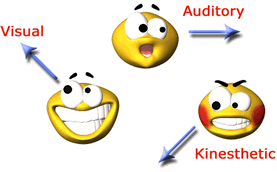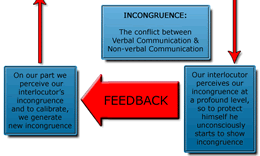NLP
Accept the person. Change the behaviour.
Neuro-linguistic programming (NLP) is a personal development system developed in the early 1970s by Richard Bandler and linguist John Grinder, in association with Gregory Bateson. It uses a toolbox of strategies, axioms and beliefs about human communication, perception and subjective experience.
 NLP’s core idea is that an individual’s thoughts, gestures and words interact to create one’s perception of the world. By changing one’s outlook, therefore, a person can improve his attitudes and actions. These observations can be changed by applying a variety of techniques.
NLP’s core idea is that an individual’s thoughts, gestures and words interact to create one’s perception of the world. By changing one’s outlook, therefore, a person can improve his attitudes and actions. These observations can be changed by applying a variety of techniques.
NLP teaches that a person can develop successful habits by amplifying helpful behaviors and diminishing negative ones. Positive change can come when one carefully reproduces the behaviors and beliefs of successful people (called ‘modeling’). It also states that all human beings have all the resources necessary for success within themselves.
Bandler and Grinder credited three successful therapists — Fritz Perls, Virginia Satir and Milton Erickson — as NLP’s major inspirations. They ‘modeled’ the therapists and developed special “patterns” for general communication, rapport-building and self-improvement. NLP author Robert Dilts calls the system “the study of the structure of subjective experience”.
What the above means in the realm of therapy is that likes of Milton  Erickson and Fritz Perls had effective strategies for brining about positive change within their clients. Richard Bandler et al found a way of formulating these strategies so that they could be expanded upon and used by all of us to affect positive changes in ourselves and those with whom we interact.
Erickson and Fritz Perls had effective strategies for brining about positive change within their clients. Richard Bandler et al found a way of formulating these strategies so that they could be expanded upon and used by all of us to affect positive changes in ourselves and those with whom we interact.
Please see the link on the right-hand-side of this page for the NLP entry on Wikipedia.
There’s no such thing as an unresourceful person. Just a person in an unresourceful state.
I like you. 😀
related articles
- New Wing Mirrors Installed! | Carver Earth EV (March 29th, 2021)
- Carver EV Test Drive UK – New Fans! (March 29th, 2021)
- Customized Carver Instagram (March 29th, 2021)
- Range Test | Carver Earth EV (March 29th, 2021)
- Wing Mirrors & Washer Fluid | Carver Earth EV (March 29th, 2021)